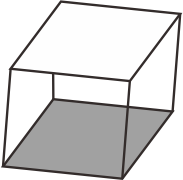Smart Math formula Volume of a Cuboid

In geometry, a cuboid is a solid shaped figure formed by six faces. There are two definitions for a cuboid. In the more general definition of a cuboid, the only supplementary condition is that each of these six faces is a quadrilateral. Otherwise, the word “cuboid” is sometimes used for referring a shape of this type in which each of the faces is a rectangle, and in which each pair of adjacent faces meets in a right angle.
- A jewellery box that has the shape of a rectangular prism, has a height of 13 cm, a length of 35 cm and a width of 22cm. Find the volume of the jewellery box?
Math Solution:
V = l × w × h
V= 13 × 35 × 22
V= 10010 cm3
V = l × w × h
V= 13 × 35 × 22
V= 10010 cm3
- Find the volume of a brick whose size is 30 cm by 25 cm by 10 cm.
Math Solution:
The volume of the brick is given by:
V = l × w × h
V = 30 × 25 × 10
V = 7500 cm3
So, the volume of the brick is 7500cm3.
Volume of the cuboid is given by:
V = l × w × h
V = 8 × 12 × 6
V = 576 cm3
The volume of the brick is given by:
V = l × w × h
V = 30 × 25 × 10
V = 7500 cm3
So, the volume of the brick is 7500cm3.
- Calculate the volume of a cuboid whose size is 8cm × 12cm × 6cm
Volume of the cuboid is given by:
V = l × w × h
V = 8 × 12 × 6
V = 576 cm3
- Given that the dimension of a cuboidal shape beam is 10m in length, 60 cm in width and 25 cm in thickness. How much does Nick have to pay for it, if it costs $250.00/ m3?
Math Solution:
Notice that all the measurements should be expressed in the same units (100 cm = 1 m). Volume of the beam = length x breadth x height (thickness here)
V = 10 x (60/100) x (25/100) = 1.5 m3
The final price of the beam will be: 1.5 x 250 = $375.00.
Notice that all the measurements should be expressed in the same units (100 cm = 1 m). Volume of the beam = length x breadth x height (thickness here)
V = 10 x (60/100) x (25/100) = 1.5 m3
The final price of the beam will be: 1.5 x 250 = $375.00.
- A goods wagon shaped in the form of cuboid of measure 60m × 40m × 30m. How many cuboidal boxes can be stored in it if the volume of one box is 0.8 cubic meters.
Math Solution:
The volume of one box = 0.8 m3
The volume of the goods wagon is: 60 × 40 × 30 = 72000 m3
Number of boxes that can be stored in the goods wagon is therefore:
72000 / 0.8 = 90000
Hence the number of cuboidal boxes that can be stored in the goods wagon is 90,000.
The volume of one box = 0.8 m3
The volume of the goods wagon is: 60 × 40 × 30 = 72000 m3
Number of boxes that can be stored in the goods wagon is therefore:
72000 / 0.8 = 90000
Hence the number of cuboidal boxes that can be stored in the goods wagon is 90,000.
- Find the height of a cuboid whose volume is 300 cubic cm and the base area is 30cm.
Math Solution:
V = l × w × h
Since the base area is defined as: l × w, the height is therefore:
h = V / base area
h = 300 / 30
h = 10 cm
V = l × w × h
Since the base area is defined as: l × w, the height is therefore:
h = V / base area
h = 300 / 30
h = 10 cm
- A box of the size 60 cm × 40 cm × 30 cm. If the size of one chocolate bar is 24 cm × 12 cm × 4 cm each, how many bars can the box hold?
Math Solution:
The volume of the box = 60 × 40 × 30 = 72000 cm3
The volume of each bar = 24 × 12 × 4 = 1152 cm3
Therefore the number of chocolate bars that the box can hold is:
72000/1152 = 62
The volume of the box = 60 × 40 × 30 = 72000 cm3
The volume of each bar = 24 × 12 × 4 = 1152 cm3
Therefore the number of chocolate bars that the box can hold is:
72000/1152 = 62
- The surface areas of the three coterminous faces of a cuboid are 6, 15 and 10 cm2 respectively. Find the volume of the cuboid.
Math Solution:
To begin with we need to determine the length, width and height of the cuboid.
l = √(6)
w = √(15)
h = √(10)
V = l × w × h
V = √(6) × √(15) × √(10)
V = 30 cm2
To begin with we need to determine the length, width and height of the cuboid.
l = √(6)
w = √(15)
h = √(10)
V = l × w × h
V = √(6) × √(15) × √(10)
V = 30 cm2




